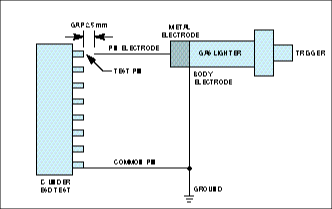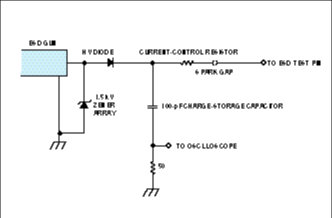| Simple ESD Gun
from IGCAR, Kalpakkam, India You can use the simple ESD-test gun in Figure 1 to test the effects of ESD through sensitive ICs. A piezo-electric type kitchen gas lighter (the so-called ESD gun) is an excellent fast-static-charge generator. This gun can cause ESD through air and also through conducting and semiconducting materials. These devices also meet home-use safety standards. To build the device, extend the main pin of the gun so that this pin nearly reaches the test pin of the IC. This distance can be as close as 2.5 mm to form a trigger gap. To fire an ESD pulse directed toward the test pin, just squeeze the gun handle, and a fine flash appears at the test pin of the IC. The amount of charge is about 0.2 µC, and the pulse duration varies from 100 nsec to 1 µsec. Because this application requires short discharge pulses and polarity is unimportant, it directly uses the charge that the piezo device generates. For this case, the spark gap ensures the minimum starting voltage and allows as many spark pulses as the device can produce per trigger. This application does not require a current-control resistor. You can measure current waveforms using a 50V resistor in the gun's ground path to form a simple ground-referenced voltage across the resistor. This test shows ac pulses typical of piezo-crystal characteristics. If you want to generate a standard voltage pulse without a spark gap, use the circuit in Figure 2. In this circuit, using a zener diode before a rectifier diode limits the voltage on the 100-pF charge-storage capacitor. Now, the stored charge can discharge through any current-control resistor into the test pin of the IC. You can still use a spark gap if a minimum starting voltage is necessary. If one piezo device produces insufficient charge per trigger, then you can store the charge by triggering the gun several times. A spark-gap switch is useful in this case. The spark gap has a threshold voltage, and the ESD pulse starts only when enough voltage develops on the capacitor.
|


